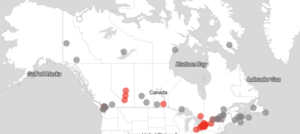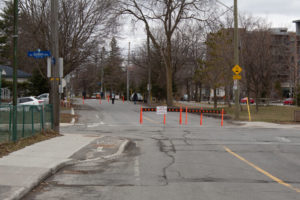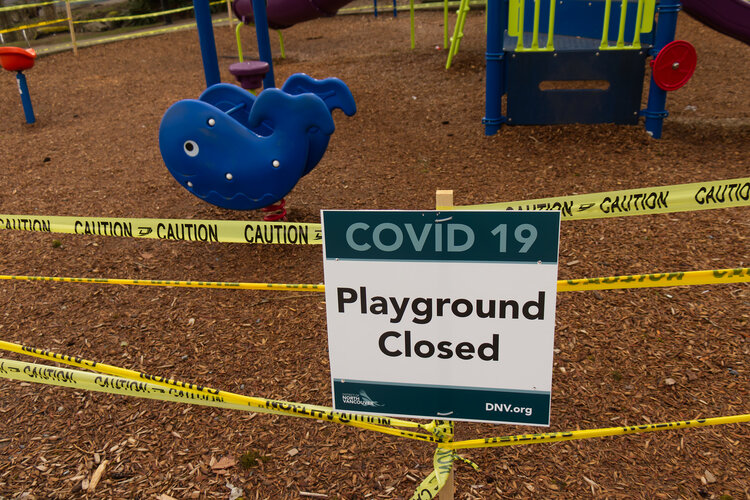Since the start of the pandemic, the darkest of times have brought out the best in our communities, with a constellation of urban innovation and experimentation emerging from coast to coast. As the order of government closest to the people, municipalities are uniquely positioned to develop place-based policies that respond directly to local contexts, needs, and opportunities. And with some cities getting hit earlier and harder than others, local governments have been looking to each other for cues on what to expect, and how to respond.
To help city builders, administrators and community members across the country to stay connected and track what’s happening on-the-ground during the COVID-19 crisis, the Canadian Urban Institute (CUI) launched three volunteer-sourced platforms. The first, CityWatch Canada, tracks emergency response measures put in place by city governments across Canada — now for 65 cities, including major urban centres in all provinces and territories, and all cities with populations over 100,000. The second, CityShare Canada, houses resources, tools and stories on how residents and city builders across sectors are responding to COVID-19. The third, CityTalk Canada, acts as a virtual town square, featuring candid conversations, analysis and commentary to make sense of the new urban reality under COVID-19.
This article draws from these platforms to highlight important trends and inspiring innovations that have emerged from local governments in particular.

Data from CityWatch Canada shows that 55 of 65 cities being tracked are in a state of emergency
The vast majority of Canada’s cities (55 of 65 being tracked by CityWatch Canada) are in a state of emergency.
The nine biggest cities, and many others, have announced local states of emergency — often ahead of their provincial and territorial counterparts. Others are captured under provincial/territorial declarations. Cities that are not in a state of emergency — for instance, Charlottetown and Iqaluit — are smaller and tend to be more remote geographically, and less likely to be initially touched by the pandemic. The state of emergency, beyond a declaration of the urgency of the crisis to residents, is important because it gives governments additional flexibility and powers to take actions for public health and security.
Robust public health measures are in place in most cities.
All of Canada’s biggest cities, and a majority overall, are enforcing social distancing policies. As has been widely reported, cities have taken their social distancing bylaw enforcement increasingly seriously as virus spread has ramped up, with controversy in some instances around tactics and ticketing. In the ten largest cities and a few others, childcare has been made available to essential workers. Some cities have faced unique challenges. For instance, Windsor city hall has had to broker arrangements for the estimated 1,600 health care workers that cross the border daily to serve in hard hit Detroit — in the midst of some sticky diplomatic issues.
Cities have taken the difficult step of fully or partially closing facilities and services.
This includes virtually all city halls, recreation facilities, public libraries, park amenities and playgrounds, and most other municipal buildings. Many critical civic services have been suspended, a big challenge for many residents and communities. A big exception: waste collection, which is service as usual across most cities. Essential operations like emergency services and water also continue untouched. In crisis, however, has come inspiring creativity and innovation. Many cities have retooled facilities for other purposes. For example, library branches have converted into food banks in Toronto, and the Halton Hills Public Library is using its 3D printers to produce face-shield parts for frontline healthcare workers.

Byron Avenue in Ottawa has been closed for pedestrian traffic only to allow for greater physical distancing.
With mobility limited by social distancing and stay-at-home policies, transportation has been severely impacted.
Public transit authorities have instituted passenger limits, rear-door entry and waived fares to enforce social distancing. The crisis has been a challenge for local transportation in many respects — creating health risks for transit workers, and a nosedive in fare revenues. But it has yielded some novel solutions. Belleville Transit, after seeing a reduction in ridership of 80%, moved to on-demand service, with customers booking trips using a transit app. Officials in cities like Calgary , Edmonton, Montreal, Winnipeg, and Ottawa like have moved to “pedestrianize” some streets, or asked residents to treat sidewalks like one-way streets, to ensure people out on essential trips are able to safely practice physical distancing.
With many services closed or reduced, others are ramping up quickly to support vulnerable populations.
All the largest cities have opened up new homeless shelter spaces and have made available homeless shelter isolation units, with most repurposing some public buildings for social services (data is limited for smaller cities). Dormant hockey rinks, convention centres, recreation buildings, and leased hotel rooms have been transformed into temporary shelters or assisted self-isolation sites.
A strong majority of cities (55 of 65) have announced some form of financial support for residents and businesses to help them get through the crisis.
A majority of cities have taken steps to defer fees for both residents and businesses, with many also providing other supports to one or both groups. These have primarily taken the shape of property tax and utility bill deferrals without penalty, and rent relief to small businesses and non-profit tenants in city facilities. Typically, the largest cities have been the most active in offering assistance.
Finally, the governance of cities has been significantly impacted.
Interestingly, cities have taken very different approaches with city council meetings. Based on the latest data, Toronto, Edmonton, Brampton and others have cancelled council meetings entirely; Calgary, Ottawa, Surrey, Winnipeg and Vancouver, among others, have shifted to virtual or teleconference meetings; while a smaller group including Montreal continue to hold in-person meetings. Formal venues of public engagement and participation, such as resident advisory committees and public meetings, have generally been cancelled, with a handful of cities shifting to virtual formats. This is understandable given the social distancing imperative, but raises questions about whether communities can represented and have voice through the crisis.
Despite the cancellation of events and public meetings, some local governments have found other ways to keep residents informed and engaged. Since the middle of March, Hamilton has been hosting weekly virtual town halls to answer resident questions about the virus and the City’s response. Vancouver’s municipal dashboard helps residents keep track of local response efforts and the status of vital public services. London’s Deputy Mayor ran an at-home civics class for children. To support collective mental health, the City of Newmarket launched a #StandApartTogether campaign, appointing “community positivity ambassadors” to spread stories about Newmarket’s “bright side” and perseverance during this time.
Cities have also quickly spun up governance models to respond to new and emerging needs of their most vulnerable residents. The City of Toronto established a City-Community Response Table with 30 community agencies to identify and respond to emerging issues facing vulnerable residents, a Community Coordination Plan with dedicated coordinators at the neighbourhood level, and a portal to solicit charitable donations from the community. In Vancouver, Mayor Kennedy Stewart announced safe drug supply for the roughly 20% to 30% of vulnerable drug users not connected to the healthcare system.
Cities are creating governance models to plan for coordinated responses and post-COVID-19 recovery as well. Local economic recovery task forces in places like Gatineau are bringing together local leaders to come up with place-based solutions to business continuity and recovery. The City of Calgary has introduced a COVID-19 Governance Structure to take a holistic approach to planning within the city administrative structure and with external stakeholders. Online campaigns like Calgary’s #SupportLocalYYC and websites like Hamilton’s Hometown Hub are connecting residents with ways to support their favourite local establishments from a distance.



